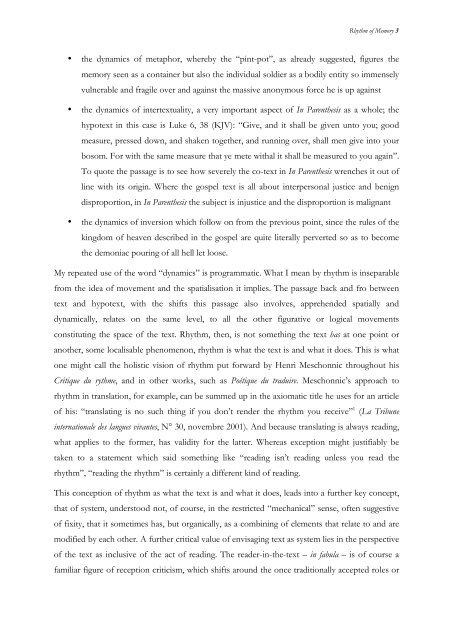The rhythm of memory: a reading of poetic rhythm in David Jones's ...
The rhythm of memory: a reading of poetic rhythm in David Jones's ...
The rhythm of memory: a reading of poetic rhythm in David Jones's ...
- No tags were found...
Create successful ePaper yourself
Turn your PDF publications into a flip-book with our unique Google optimized e-Paper software.
Rhythm <strong>of</strong> Memory 3• the dynamics <strong>of</strong> metaphor, whereby the “p<strong>in</strong>t-pot”, as already suggested, figures the<strong>memory</strong> seen as a conta<strong>in</strong>er but also the <strong>in</strong>dividual soldier as a bodily entity so immenselyvulnerable and fragile over and aga<strong>in</strong>st the massive anonymous force he is up aga<strong>in</strong>st• the dynamics <strong>of</strong> <strong>in</strong>tertextuality, a very important aspect <strong>of</strong> In Parenthesis as a whole; thehypotext <strong>in</strong> this case is Luke 6, 38 (KJV): “Give, and it shall be given unto you; goodmeasure, pressed down, and shaken together, and runn<strong>in</strong>g over, shall men give <strong>in</strong>to yourbosom. For with the same measure that ye mete withal it shall be measured to you aga<strong>in</strong>”.To quote the passage is to see how severely the co-text <strong>in</strong> In Parenthesis wrenches it out <strong>of</strong>l<strong>in</strong>e with its orig<strong>in</strong>. Where the gospel text is all about <strong>in</strong>terpersonal justice and benigndisproportion, <strong>in</strong> In Parenthesis the subject is <strong>in</strong>justice and the disproportion is malignant• the dynamics <strong>of</strong> <strong>in</strong>version which follow on from the previous po<strong>in</strong>t, s<strong>in</strong>ce the rules <strong>of</strong> thek<strong>in</strong>gdom <strong>of</strong> heaven described <strong>in</strong> the gospel are quite literally perverted so as to becomethe demoniac pour<strong>in</strong>g <strong>of</strong> all hell let loose.My repeated use <strong>of</strong> the word “dynamics” is programmatic. What I mean by <strong>rhythm</strong> is <strong>in</strong>separablefrom the idea <strong>of</strong> movement and the spatialisation it implies. <strong>The</strong> passage back and fro betweentext and hypotext, with the shifts this passage also <strong>in</strong>volves, apprehended spatially anddynamically, relates on the same level, to all the other figurative or logical movementsconstitut<strong>in</strong>g the space <strong>of</strong> the text. Rhythm, then, is not someth<strong>in</strong>g the text has at one po<strong>in</strong>t oranother, some localisable phenomenon, <strong>rhythm</strong> is what the text is and what it does. This is whatone might call the holistic vision <strong>of</strong> <strong>rhythm</strong> put forward by Henri Meschonnic throughout hisCritique du rythme, and <strong>in</strong> other works, such as Poétique du traduire. Meschonnic’s approach to<strong>rhythm</strong> <strong>in</strong> translation, for example, can be summed up <strong>in</strong> the axiomatic title he uses for an article<strong>of</strong> his: “translat<strong>in</strong>g is no such th<strong>in</strong>g if you don’t render the <strong>rhythm</strong> you receive” 1 (La Tribune<strong>in</strong>ternationale des langues vivantes, N° 30, novembre 2001). And because translat<strong>in</strong>g is always <strong>read<strong>in</strong>g</strong>,what applies to the former, has validity for the latter. Whereas exception might justifiably betaken to a statement which said someth<strong>in</strong>g like “<strong>read<strong>in</strong>g</strong> isn’t <strong>read<strong>in</strong>g</strong> unless you read the<strong>rhythm</strong>”, “<strong>read<strong>in</strong>g</strong> the <strong>rhythm</strong>” is certa<strong>in</strong>ly a different k<strong>in</strong>d <strong>of</strong> <strong>read<strong>in</strong>g</strong>.This conception <strong>of</strong> <strong>rhythm</strong> as what the text is and what it does, leads <strong>in</strong>to a further key concept,that <strong>of</strong> system, understood not, <strong>of</strong> course, <strong>in</strong> the restricted “mechanical” sense, <strong>of</strong>ten suggestive<strong>of</strong> fixity, that it sometimes has, but organically, as a comb<strong>in</strong><strong>in</strong>g <strong>of</strong> elements that relate to and aremodified by each other. A further critical value <strong>of</strong> envisag<strong>in</strong>g text as system lies <strong>in</strong> the perspective<strong>of</strong> the text as <strong>in</strong>clusive <strong>of</strong> the act <strong>of</strong> <strong>read<strong>in</strong>g</strong>. <strong>The</strong> reader-<strong>in</strong>-the-text – <strong>in</strong> fabula – is <strong>of</strong> course afamiliar figure <strong>of</strong> reception criticism, which shifts around the once traditionally accepted roles or
















